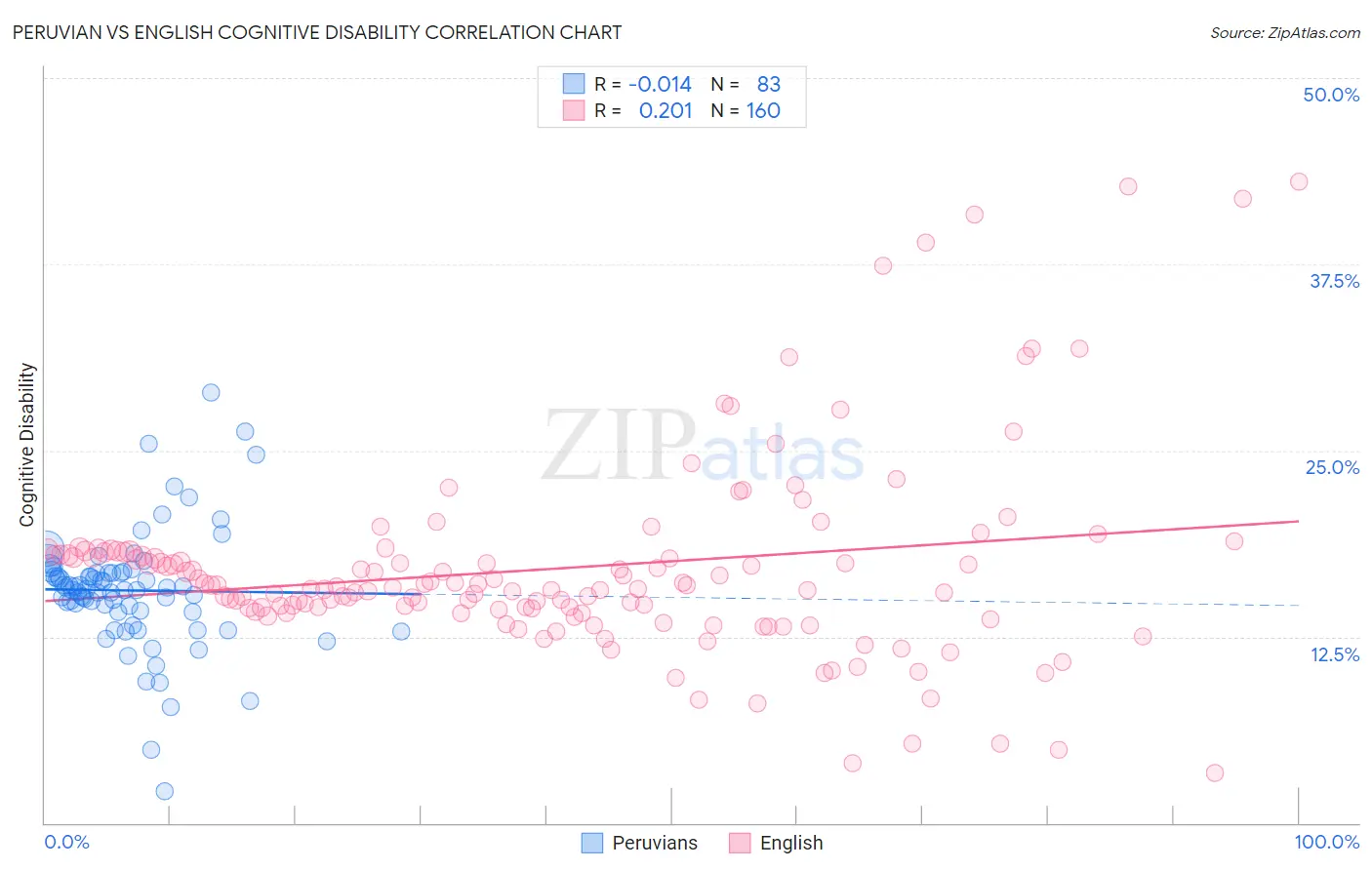Peruvian vs English Cognitive Disability
COMPARE
Peruvian
English
Cognitive Disability
Cognitive Disability Comparison
Peruvians
English
16.7%
COGNITIVE DISABILITY
99.3/ 100
METRIC RATING
78th/ 347
METRIC RANK
16.8%
COGNITIVE DISABILITY
98.6/ 100
METRIC RATING
95th/ 347
METRIC RANK
Peruvian vs English Cognitive Disability Correlation Chart
The statistical analysis conducted on geographies consisting of 363,189,902 people shows no correlation between the proportion of Peruvians and percentage of population with cognitive disability in the United States with a correlation coefficient (R) of -0.014 and weighted average of 16.7%. Similarly, the statistical analysis conducted on geographies consisting of 579,706,008 people shows a weak positive correlation between the proportion of English and percentage of population with cognitive disability in the United States with a correlation coefficient (R) of 0.201 and weighted average of 16.8%, a difference of 0.52%.

Cognitive Disability Correlation Summary
| Measurement | Peruvian | English |
| Minimum | 2.1% | 3.4% |
| Maximum | 28.9% | 43.0% |
| Range | 26.8% | 39.7% |
| Mean | 15.6% | 17.1% |
| Median | 15.7% | 15.8% |
| Interquartile 25% (IQ1) | 14.2% | 14.3% |
| Interquartile 75% (IQ3) | 16.8% | 18.1% |
| Interquartile Range (IQR) | 2.6% | 3.8% |
| Standard Deviation (Sample) | 4.0% | 6.6% |
| Standard Deviation (Population) | 4.0% | 6.6% |
Demographics Similar to Peruvians and English by Cognitive Disability
In terms of cognitive disability, the demographic groups most similar to Peruvians are Immigrants from Hungary (16.7%, a difference of 0.0%), Immigrants from Serbia (16.7%, a difference of 0.010%), Immigrants from Bulgaria (16.7%, a difference of 0.010%), Egyptian (16.7%, a difference of 0.030%), and Immigrants from Netherlands (16.7%, a difference of 0.040%). Similarly, the demographic groups most similar to English are Finnish (16.8%, a difference of 0.020%), Asian (16.7%, a difference of 0.060%), Immigrants from South America (16.7%, a difference of 0.11%), Immigrants from Southern Europe (16.7%, a difference of 0.11%), and Danish (16.7%, a difference of 0.12%).
| Demographics | Rating | Rank | Cognitive Disability |
| Immigrants | Serbia | 99.3 /100 | #76 | Exceptional 16.7% |
| Immigrants | Hungary | 99.3 /100 | #77 | Exceptional 16.7% |
| Peruvians | 99.3 /100 | #78 | Exceptional 16.7% |
| Immigrants | Bulgaria | 99.3 /100 | #79 | Exceptional 16.7% |
| Egyptians | 99.2 /100 | #80 | Exceptional 16.7% |
| Immigrants | Netherlands | 99.2 /100 | #81 | Exceptional 16.7% |
| Swiss | 99.2 /100 | #82 | Exceptional 16.7% |
| Serbians | 99.1 /100 | #83 | Exceptional 16.7% |
| Belgians | 99.1 /100 | #84 | Exceptional 16.7% |
| Immigrants | Moldova | 99.1 /100 | #85 | Exceptional 16.7% |
| Immigrants | South Africa | 99.0 /100 | #86 | Exceptional 16.7% |
| Native Hawaiians | 99.0 /100 | #87 | Exceptional 16.7% |
| Immigrants | Philippines | 99.0 /100 | #88 | Exceptional 16.7% |
| Immigrants | Egypt | 98.8 /100 | #89 | Exceptional 16.7% |
| South Americans | 98.8 /100 | #90 | Exceptional 16.7% |
| Danes | 98.8 /100 | #91 | Exceptional 16.7% |
| Immigrants | South America | 98.8 /100 | #92 | Exceptional 16.7% |
| Immigrants | Southern Europe | 98.7 /100 | #93 | Exceptional 16.7% |
| Asians | 98.7 /100 | #94 | Exceptional 16.7% |
| English | 98.6 /100 | #95 | Exceptional 16.8% |
| Finns | 98.5 /100 | #96 | Exceptional 16.8% |